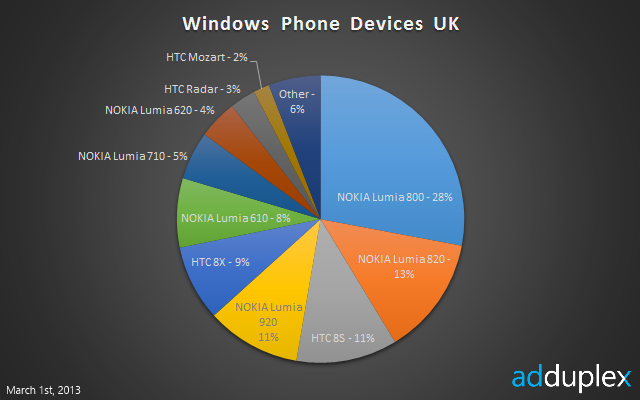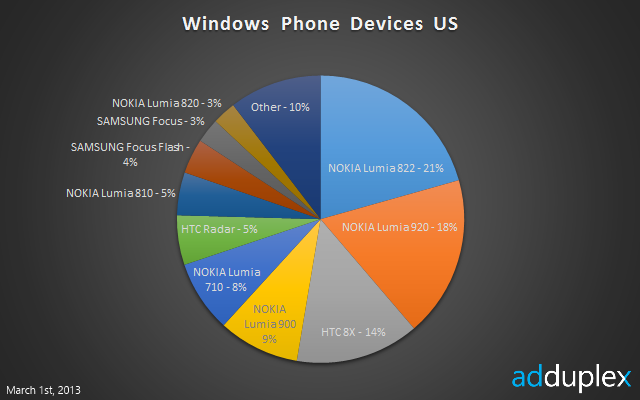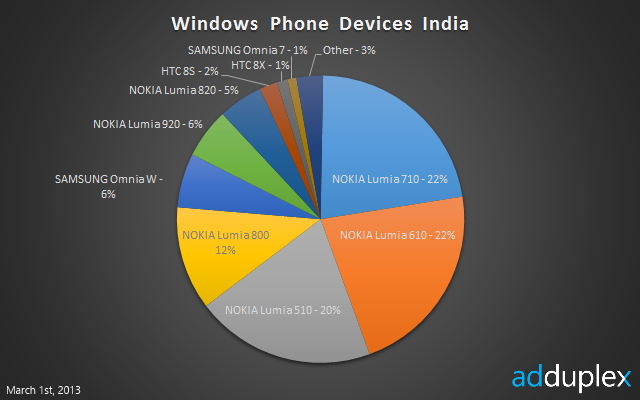Some of the key data points from AdDuplex's global report include:
- Nokia Lumia devices represent 78.1% of devices detected by AdDuplex, followed by HTC (14.6%), Samsung (5.6%) and LG (1.2%).
- Windows Phone 8 devices represent 31% of devices detected by AdDuplex
- The leading countries are the US (11%), India (7.6%), China (7.5%), Mexico (7.5%), Italy (7.4%), Russia (6.6%) and the UK (5.4%).
The data for global device breakdown shows that Nokia is dominant, taking all six of the top device slots, and eight of the top ten. HTC is comfortably in the second spot, with Samsung and Huawei lost in the "Others" categorisation. However, the dominance of Nokia is perhaps best illustrated by the fact a single device, in a single country, on a single operator (the Lumia 822 on Verizon in the US), represents almost the same proportion of the installed based as all the HTC 8Xs across all countries and operators.

AdDuplex also provides device breakdown data for a number of other countries, which we have collated into a table below. Given the data is essentially measuring the active installed base it's no surprise that Windows Phone 7.5 devices, led by the Lumia 800, are dominant having been on sale longer, but Windows Phone 8 is making steady progress and is already making up a significant proportion of devices in some countries (61% in the US, 48% in the UK, 42% in the Netherlands), indicative of strong and growing sales.
The data also shows lower end devices (e.g. Nokia Lumia 710 / HTC Radar and below) generally make up a greater proportion of the installed based than higher end devices (e.g. Nokia Lumia 800 and above). Again it's no surprise that cheaper devices sell in greater quantities, but given the higher end devices receive the lion's share of the media's attention a reminder is always apposite.

The data for the UK device breakdown shows the Lumia 800 remains dominant, but Windows Phone 8 devices are making in-roads. Notable is the HTC 8S, which has only been available for a relatively short period, but has been pushed as a lower end smartphone by a number of operators (e.g. 3). The Lumia 820 (13%) makes up a greater proption of the installed base than the Lumia 920 (11%), a mirror image to global trends, but, taking into account the addressable market, there's not enough of difference to come to a defintive conclusion about the impact of the EE exclusivity agreement.

The data for the US device breakdown indicates that the Lumia 822 is enjoying considerable sucess on the Verizon network, making up a greater proportion of the installed based than the Lumia 920 (only available on AT&T). In part this may be due to latent demand for Windows Phone 8 devices on Verizon, but even so it's an encouraging sign for the platform. It's also notable that the the three Lumia 8xx variants (822, 820, 810), collectively representing 29%, have out performed the HTC 8X (14%), which is also available on three US carriers.

The data for India is a good example of how the breakdown of devices in the installed based can vary greatly from country to country. India is dominated by lower end devices, with the Nokia Lumia 710, 610 and 510 collectively representing almost two thirds of active Windows Phone devices in the country. The Lumia 510 is especially notable, given that it has only be on sale for a few months. This would suggest the recently announced Lumia 520 and Lumia 720 should do well in India and other emerging markets.

You can read the full report on the AdDuplex blog.
